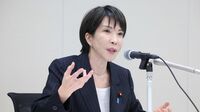
This is the third part of the dialogue between Toyo Keizai special correspondent Richard Katz and famed economist Noah Smith. It was done on the occasion of the simultaneous publication of the Japanese translation of Katz’s book The Contest for Japan’s Economic Future: Entrepreneurs Vs. Corporate Giants and Smith’s book, Weeb Economy: The Weebs Will Save Japan. Weebs are fans of Japanese culture. Toyo Keizai journalist Misa Kurasawa moderated the discussion.
Smith: Another essential requirement for Japanese recovery is more exports. Inward Foreign Direct Investment (FDI)—foreign companies building factories, research centers, back offices, and so forth in Japan—can help. There's a stereotype that Japan is a strong exporter. This has never been true. Even during its era of rapid growth, exports never exceeded 15% of GDP. And now with the weak yen, that's increasing. So, exports account for up to 22% of GDP. In Korea, it’s 60%, in France, it’s in the 40s. America’s ratio is lower than Japan’s, but this isn't good for America, so Japan should not copy us in this regard. Japan is a small and shrinking market. To grow, it needs to export more. And so it needs FDI oriented toward exports, be it M&A (foreign companies buying Japanese ones) or Greenfield (brand new operations), although Greenfield does this much more often than M&A. But whatever type of FDI you have, exporting should be a goal.
Katz: I totally agree. Exports or imports as a share of GDP are a function of a country’s population; the smaller the population, the bigger the ratio of trade to GDP. So, you’d expect the US to have a smaller share than Japan since it has almost triple the population. But, Japanese exports have always been too low for a country with its population. And one reason is that its imports are too low. A pillar of trade theory is that barriers to imports act as barriers to exports. The reason is that there’s an economic and political limit to how large your trade surplus can get and how much the rest of the world can absorb. That’s particularly true if you’re a large country, like Japan or China. So, let’s say Japan tends to run a trade surplus of 2% of GDP (it’s currently running a deficit). If you only import 20% of GDP, you can’t export more than 22% of GDP. But if you import 40% of GDP, then you can export 42%. Countries with higher overall levels of trade have higher growth, regardless of whether they run surpluses or deficits.
Smith: It is beyond me why people focus so much on the trade surplus or deficit and ignore the gross numbers. If you have neither a surplus nor a deficit, and go from importing 10% and exporting 10% to importing 40% and exporting 40%, you will be much more connected to the global economy. You will have much higher multiplier effects from external revenue and thus higher growth, even though the trade balance stays the same. I can't stand it that we are now seeing America destroy its own economy because the people in charge are solely focused on trade deficits.
Katz: Yes, Trump is moving America to the old Latin American “import substitution” model of growth that performed so badly compared to Asia’s “export-led growth” model.
Why do open economies (those with a high trade-to-GDP ratio) grow faster than relatively closed ones? One reason is that you are exposed to other countries’ techniques and learn from them. Companies learn from their suppliers and customers. Another is because you’re exposed to global competition. Japan’s productivity was always higher in industrial sectors that were more subject to international competition through trade than in the purely domestically-oriented sectors. Competition is far more potent than corporate government in improving company performance. Finally, you have a bigger market for the goods and services in which you are more competitive than your trading partners. So, you produce more of the products in which you excel and fewer of those where you’re not very good. That shift automatically leads to higher per capita GDP.
Trump is playing a negative-sum game: i.e., he’s not only hurting other countries, but also hurting America.
Smith: Having too big a market at home can be a curse, especially if it is cossetted and coddled. Even before Trump, while we didn’t have high trade barriers, companies always found it easier to sell at home than to another country. This has hurt America.
It is going to hurt China, too, down the road. In 20 years, Chinese companies will be too inwardly focused. BYD auto will be international. It'll be the new Toyota. But you'll see 90% of Chinese companies stagnating because they'll only focus on China.
Katz: That’s also a big problem for Japanese startups financed by venture capital. They tend to focus on the home market because it’s so big. They should aim at the global market from the beginning, as is the case with so many American startups. I’d love to see more American and European venture capitalists in Japan, because they could mentor Japanese entrepreneurs regarding this part of strategy. Japanese corporate Venture Capital is not doing this.
To me, exports are just one ingredient in the broader globalization that I think is indispensable to Japanese recovery.
When I was interviewing all these young entrepreneurs for my book, every successful young founder I met had some foreign exposure. Some spent time abroad because their father had an overseas job. Some went to a foreign university for at least a year or so. Others worked for a foreign company operating in Japan. People with exposure to a variety of cultures think more fluidly.
These days, 85% of executives in North American and European companies—CEOs, chief financial officers, chief technology officers, etc.—have spent some time being the head of a foreign affiliate of either their company or a different company. And it's not just because they're operating globally, which forces them to think about other countries. It's because that experience improves the way they operate domestically. They find out that there’s more than one way to see a problem and to solve it. So the domestic performance of the company is better. However, only 15% of the executives in Japan have had that kind of foreign exposure. Too often, they don't even know what's going on elsewhere. Until Stanford professor Dan Okimoto brought a bunch of top Japanese CEOs to Silicon Valley, they had no idea how far behind they were in the digital technology frontier.
Fewer Japanese students study abroad than a couple of decades ago because it doesn’t help them get promoted, and some companies have elongated the recruitment process, which creates a bigger disincentive to study overseas.
Japanese scientists and technologists collaborate less with their counterparts in other countries, which hurts their research's creativity.
Kurasawa: Can you comment on the notion of open innovation?”
Katz: In the analog era in which today’s corporate giants in Japan grew up, open innovation was not required. Each corporation, along with its vertical keiretsu allies, could do everything by itself. In the digital era, open innovation is not only growing; it’s required. Pfizer did not invent its Covid vaccine; it was done for it by a German startup. It’s not just in high-tech. Procter & Gamble, the giant household goods company, set a goal that 40% of its revenue would come from collaborations with other companies. Some are in America; some overseas. Some are big; some are small, e.g., just a couple hundred employees. That helps both P&G as well as the new innovative companies. Japanese companies talk about open innovation, but few do it well.
With a few exceptions, Japan lags. KDDI is working hard to collaborate with developers for its mobile phone apps. Toyota collaborates with independent software vendors because its in-house technologists have not mastered digital technology. But they are the exception. Digital pervades every sector, but when you measure how much benefit Japanese companies get for every dollar they invest in digital technology, Japan comes in 64th out of 64 countries.
Smith: The Internet has decreased the cost of sharing information across companies, but not within companies. So, there is a big shift for companies regarding what should be done in-house and what should be sourced from other companies.
Companies that keep too much stuff in-house produce the wrong things for today’s technology. And so Johnson & Johnson is a perfect example because they're outsourcing a lot of their R&D and keeping commercialization in-house. The R&D is outsourced to biotech startups that are mostly VC-funded. And then, as soon as a biotech startup drug clears clinical trials, the biotech companies will sell it to a pharmaceutical giant, and the latter will produce it, market it, and so forth.
So, the boundaries of what each firm should do are changing. Many Japanese companies have been slow to adopt the management style required to thrive in the new digital era. Japanese companies do need to reform themselves. Some will and some won't.



